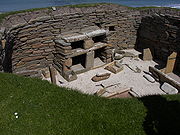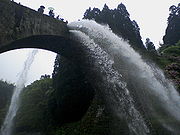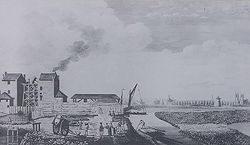
History of water supply and sanitation
Encyclopedia







Water supply
Water supply is the provision of water by public utilities, commercial organisations, community endeavours or by individuals, usually via a system of pumps and pipes...
, plumbing
Plumbing
Plumbing is the system of pipes and drains installed in a building for the distribution of potable drinking water and the removal of waterborne wastes, and the skilled trade of working with pipes, tubing and plumbing fixtures in such systems. A plumber is someone who installs or repairs piping...
, sanitation
Sanitation
Sanitation is the hygienic means of promoting health through prevention of human contact with the hazards of wastes. Hazards can be either physical, microbiological, biological or chemical agents of disease. Wastes that can cause health problems are human and animal feces, solid wastes, domestic...
and sewage collection and disposal
Sewage collection and disposal
Sewage collection and disposal systems transport sewage through cities and other inhabited areas to sewage treatment plants to protect public health and prevent disease. Sewage is treated to control water pollution before discharge to surface waters....
.
Ancient age
During the NeolithicNeolithic
The Neolithic Age, Era, or Period, or New Stone Age, was a period in the development of human technology, beginning about 9500 BC in some parts of the Middle East, and later in other parts of the world. It is traditionally considered as the last part of the Stone Age...
, man dug the first permanent water well
Water well
A water well is an excavation or structure created in the ground by digging, driving, boring or drilling to access groundwater in underground aquifers. The well water is drawn by an electric submersible pump, a trash pump, a vertical turbine pump, a handpump or a mechanical pump...
s, from where vessels could be filled and carried by hand. The size of human settlements was largely dependent on nearly available water. Pit toilet
Pit toilet
A pit toilet is a dry toilet system which collects human excrement in a large container and range from a simple slit trench to more elaborate systems with ventilation. They are more often used in rural and wilderness areas as well as in much of the developing world...
s and potties were the only alternative to defecation
Defecation
Defecation is the final act of digestion by which organisms eliminate solid, semisolid or liquid waste material from the digestive tract via the anus. Waves of muscular contraction known as peristalsis in the walls of the colon move fecal matter through the digestive tract towards the rectum...
in the open, until flush toilet
Flush toilet
A flush toilet is a toilet that disposes of human waste by using water to flush it through a drainpipe to another location. Flushing mechanisms are found more often on western toilets , but many squat toilets also are made for automated flushing...
s appeared in mid 19th century. Devices such as shadoof
Shadoof
A shadoof, shaduf, dhenkli, picottah or counterpoise-lift is an irrigation tool...
s, and sakia
Sakia
A sakia , tympanum or tablia is a water wheel, somewhat similar to a noria, and used primarily in Egypt. It is a large hollow wheel, normally made of galvanized sheet steel, with scoops or buckets at the periphery...
s have been used to lift water to ground level.
Throughout history people have devised systems to make getting and using water more convenient. The Indus Valley Civilization
Indus Valley Civilization
The Indus Valley Civilization was a Bronze Age civilization that was located in the northwestern region of the Indian subcontinent, consisting of what is now mainly modern-day Pakistan and northwest India...
has early evidence of public water supply and sanitation. The Roman Empire
Roman Empire
The Roman Empire was the post-Republican period of the ancient Roman civilization, characterised by an autocratic form of government and large territorial holdings in Europe and around the Mediterranean....
had indoor plumbing, meaning a system of aqueduct
Aqueduct
An aqueduct is a water supply or navigable channel constructed to convey water. In modern engineering, the term is used for any system of pipes, ditches, canals, tunnels, and other structures used for this purpose....
s and pipes that terminated in homes and at public wells and fountains for people to use. Rome and other nations used lead
Lead
Lead is a main-group element in the carbon group with the symbol Pb and atomic number 82. Lead is a soft, malleable poor metal. It is also counted as one of the heavy metals. Metallic lead has a bluish-white color after being freshly cut, but it soon tarnishes to a dull grayish color when exposed...
pipes, often unknowing about lead poisoning
Lead poisoning
Lead poisoning is a medical condition caused by increased levels of the heavy metal lead in the body. Lead interferes with a variety of body processes and is toxic to many organs and tissues including the heart, bones, intestines, kidneys, and reproductive and nervous systems...
.
Persian Qanat
Qanat
A qanāt is a water management system used to provide a reliable supply of water for human settlements and irrigation in hot, arid and semi-arid climates...
s have been used for water supply and cooling in the Middle East.
Middle and early modern age
Pail closetPail closet
A pail closet was a room used for the disposal of human excreta, under the pail system of waste removal. The closet was a small outdoor privy which contained a seat, underneath which a portable receptacle was placed. This pail, into which the user would defecate, was removed and emptied by the...
s, outhouse
Outhouse
An outhouse is a small structure separate from a main building which often contained a simple toilet and may possibly also be used for housing animals and storage.- Terminology :...
s, and cesspit
Cesspit
A cesspit, or cesspool is a pit, conservancy tank, or covered cistern, which can be used to dispose of urine and feces, and more generally of all sewage and refuse. It is a more antiquated solution than a sewer system. Traditionally, it was a deep cylindrical chamber dug into the earth, having...
s were used to collect human waste. The use of human waste as fertilizer
Fertilizer
Fertilizer is any organic or inorganic material of natural or synthetic origin that is added to a soil to supply one or more plant nutrients essential to the growth of plants. A recent assessment found that about 40 to 60% of crop yields are attributable to commercial fertilizer use...
was especially important in China and Japan, where cattle manure was less available. See toilets in Japan
Toilets in Japan
There are two styles of toilets commonly found in Japan. The oldest type is a simple squat toilet, which is still somewhat common in public conveniences. After World War II, modern Western-type flush toilets and urinals became common. The current state of the art for Western-style toilets is the...
. After the adoption of gunpowder, municipal outhouses became a important source of raw material for the making of saltpeter
Saltpeter
Saltpeter or saltpetre often refers to:*Potassium nitrate, or the mineral niter, the critical oxidizing component of gunpowder, and a food preservative.It may also refer to:...
in European countries. In London, the contents of the city's outhouses were collected every night by commissioned wagons and delivered to the nitrite beds where it was sown into the special soil beds to produce earth rich in mineral nitrates. The nitrate rich-earth is then further processed to produce saltpeter, or potassium nitrate
Potassium nitrate
Potassium nitrate is a chemical compound with the formula KNO3. It is an ionic salt of potassium ions K+ and nitrate ions NO3−.It occurs as a mineral niter and is a natural solid source of nitrogen. Its common names include saltpetre , from medieval Latin sal petræ: "stone salt" or possibly "Salt...
, an important ingredient in black powder.
London water supply infrastructure
London water supply infrastructure
London's water supply infrastructure has developed over the centuries in line with the expansion of London and now represents a sizeable infrastructure investment. For much of London's history, private companies supplied fresh water to various parts of London from the River Thames and the River Lea...
developed over many centuries from early mediaeval conduits, through major 19th century treatment works built in response to cholera
Cholera
Cholera is an infection of the small intestine that is caused by the bacterium Vibrio cholerae. The main symptoms are profuse watery diarrhea and vomiting. Transmission occurs primarily by drinking or eating water or food that has been contaminated by the diarrhea of an infected person or the feces...
threats, to modern large scale reservoirs. The trap
Trap (plumbing)
In plumbing, a trap is a U-, S-, or J-shaped pipe located below or within a plumbing fixture. An S-shaped trap is also known as the S-bend invented by Alexander Cummings in 1775 but became known as the U-bend following the introduction of the U-shaped trap by Thomas Crapper in 1880. The new U-bend...
was invented in 1775. Fire hydrant
Fire hydrant
A fire hydrant , is an active fire protection measure, and a source of water provided in most urban, suburban and rural areas with municipal water service to enable firefighters to tap into the municipal water...
s were introduced in the 18th and 19th century.
Industrial age
The first screw-down water tap was patented in 1845. The germ theory of diseaseGerm theory of disease
The germ theory of disease, also called the pathogenic theory of medicine, is a theory that proposes that microorganisms are the cause of many diseases...
emphasized the need of clean water supply, separated from sewerage. The 1854 Broad Street cholera outbreak
1854 Broad Street cholera outbreak
The Broad Street cholera outbreak was a severe outbreak of cholera that occurred near Broad Street in Soho district of London, England in 1854...
in London was a well-known case.
Water tower
Water tower
A water tower or elevated water tower is a large elevated drinking water storage container constructed to hold a water supply at a height sufficient to pressurize a water distribution system....
s appeared around the late 19th century, as building height rose, and steam, electric and diesel-powered water pump
Water Pump
Water Pump is one of the neighbourhoods of Gulberg Town in Karachi, Sindh, Pakistan. It is near main Water Pump that supplies fresh water to the city of Karachi....
s became available. As skyscraper
Skyscraper
A skyscraper is a tall, continuously habitable building of many stories, often designed for office and commercial use. There is no official definition or height above which a building may be classified as a skyscraper...
s appeared, they needed rooftop water tower
Rooftop water tower
A rooftop water tower is a variant of a water tower, consisting of a water container on a roof of a tall building.This structure supplies water pressure to floors at higher elevation than public water towers....
s.
The technique of purification of drinking water by use of compressed liquefied chlorine gas was developed in 1910 by U.S. Army Major
Major
Major is a rank of commissioned officer, with corresponding ranks existing in almost every military in the world.When used unhyphenated, in conjunction with no other indicator of rank, the term refers to the rank just senior to that of an Army captain and just below the rank of lieutenant colonel. ...
(later Brig. Gen.
Brigadier General
Brigadier general is a senior rank in the armed forces. It is the lowest ranking general officer in some countries, usually sitting between the ranks of colonel and major general. When appointed to a field command, a brigadier general is typically in command of a brigade consisting of around 4,000...
) Carl Rogers Darnall
Carl Rogers Darnall
Brigadier General Carl Rogers Darnall was a United States Army chemist and surgeon credited with originating the technique of liquid chlorination of drinking water...
(1867–1941), Professor of Chemistry at the Army Medical School
Army Medical School
Founded by U.S. Army Brigadier General George Miller Sternberg, MD in 1893, the Army Medical School was by some reckonings the world's first school of public health and preventive medicine...
. Shortly thereafter, Major (later Col.
Colonel
Colonel , abbreviated Col or COL, is a military rank of a senior commissioned officer. It or a corresponding rank exists in most armies and in many air forces; the naval equivalent rank is generally "Captain". It is also used in some police forces and other paramilitary rank structures...
) William J. L. Lyster (1869–1947) of the Army Medical Department used a solution of calcium hypochlorite
Calcium hypochlorite
Calcium hypochlorite is a chemical compound with formula 2. It is widely used for water treatment and as a bleaching agent...
in a linen bag to treat water. For many decades, Lyster's method remained the standard for U.S. ground forces in the field and in camps, implemented in the form of the familiar Lyster Bag (also spelled Lister Bag). Darnall's work became the basis for present day systems of municipal water purification.
The first successful district heating
District heating
District heating is a system for distributing heat generated in a centralized location for residential and commercial heating requirements such as space heating and water heating...
system was introduced in Lockport, New York, in 1877.
Desalination
Desalination
Desalination, desalinization, or desalinisation refers to any of several processes that remove some amount of salt and other minerals from saline water...
appeared during the late 20th century, and is still limited to a few areas.
Current development
During the beginning of the 21st Century, especially in areas of urban and suburban population centres, traditional centralized infrastructure have not been able to supply sufficient quantities of water to keep up with growing demand. Among several options that have been managed are the extensive use of desalination technology, this is especially prevalent in coastal areas and in "dry" countries like Australia. Decentralization of water infrastructure has grown extensively as a viable solution including Rainwater harvestingRainwater harvesting
Rainwater harvesting is the accumulating and storing of rainwater for reuse before it reaches the aquifer. It has been used to provide drinking water, water for livestock, water for irrigation, as well as other typical uses. Rainwater collected from the roofs of houses and local institutions can...
and Stormwater harvesting
Stormwater harvesting
Stormwater harvesting is the collection, accumulation, treatment or purification, and storing of stormwater for its eventual reuse. It differs from rainwater harvesting as the runoff is collected from drains or creeks, rather than roofs...
where policies are eventually tending towards a more rational use and sourcing of water incorporation concepts such as "Fit for Purpose".
Fresh water is an objective among the Millennium Development Goals
Millennium Development Goals
The Millennium Development Goals are eight international development goals that all 193 United Nations member states and at least 23 international organizations have agreed to achieve by the year 2015...
.
See also
- Ab AnbarAb AnbarAn āb anbār is a traditional reservoir or cistern of drinking water in Persian antiquity. The Persian phrase literally translates as "water reservoir".-The structure:...
- History of constructionHistory of constructionPeople have constructed buildings and other structures since prehistory, including bridges, amphitheatres, dams, electricity pylons, roads and canals. Building materials in present use have a long history and some of the structures built thousands of years ago can still be regarded as remarkable....
- Water industryWater industryThe water industry provides drinking water and wastewater services to residential, commercial, and industrial sectors of the economy. The water industry includes manufacturers and suppliers of bottled water...

